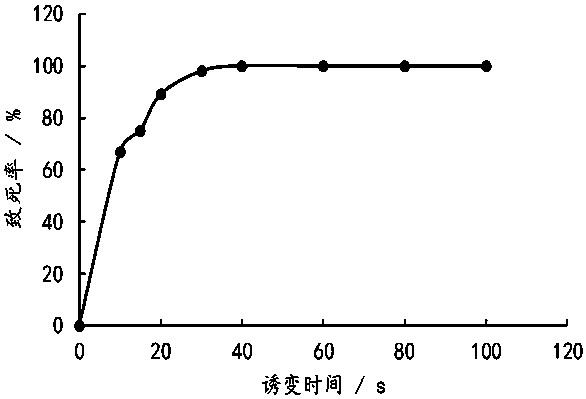A strain for enhancing glycerol metabolism and its application
A technology of glycerol metabolism and bacterial strains, applied in the direction of bacteria, microorganism-based methods, biochemical equipment and methods, etc., can solve the problems of accumulation and inhibition of microbial cell growth, restore growth ability, change growth and metabolic performance, and achieve high efficiency The effect of using
- Summary
- Abstract
- Description
- Claims
- Application Information
AI Technical Summary
Problems solved by technology
Method used
Image
Examples
Embodiment 1
[0026] This example illustrates the construction method of the Actinobacillus succinogenes JF1315 strain of the present invention.
[0027] Actinobacillus succinate ( Actinobacillus succinogenes ) NJ113 strain has been disclosed in the patent previously applied by the same inventor, the patent number is ZL200610085415.9, and the preservation number is CGMCC No.1716.
[0028] Actinobacillus succinogenes ( Actinobacillus succinogenes ) JF1315 strain was produced by Actinobacillus succinogenes ( Actinobacillus succinogenes ) NJ113 was screened by ARTP mutagenesis.
[0029] The specific mutagenesis screening steps are as follows:
[0030] ARTP mutagenesis: the starting strain Actinobacillus succinogenes NJ113 was inoculated in an anaerobic serum bottle containing seed medium and cultured for 6-12 hours to obtain a strain in logarithmic growth phase. Properly dilute the seed culture solution to OD 660= 0.5-1.5 and then spread on the cooled slide for mutagenesis. The mutag...
Embodiment 2
[0037] This embodiment illustrates the physiological and biochemical characteristics of Actinobacillus succinogenes JF1315 obtained in the above-mentioned embodiment 1, specifically as follows:
[0038] Mutagenized strains and original bacteria Actinobacillus succinogenes There is no significant difference in the colony morphology and growth performance of NJ113: the strain is Gram-negative, and the plate colonies are round, with neat and smooth edges. Under anaerobic conditions, they can metabolize glucose and xylose to synthesize organic acids, and the main acid is succinic acid. , acetic acid, lactic acid and formic acid. The strain is glutamate-deficient and requires the addition of glutamate for growth on synthetic media.
[0039] The genetic stability test of Actinobacillus succinogenes JF1315 in Example 1, the strain subculture and fermentation experiments are as follows.
[0040] Mutagenized strain Actinobacillus succinogenes JF1315 was continuously subcultured ...
Embodiment 3
[0044] This embodiment illustrates the bacterial strain after mutagenesis in the present invention Actinobacillus succinogenes The superiority of JF1315 compared with the starting strain.
[0045] In the present invention, the Actinobacillus succinicum NJ113 and JF1315 strains are cultured on a solid plate medium and then inoculated into a seed medium for cultivation to obtain a seed liquid; then the seed liquid is inoculated into a low-pH fermentation medium for anaerobic fermentation. The method may include the steps of:
[0046] (1) Actinobacillus succinogenes NJ113 and JF1315 strains were activated on solid plate medium and then transferred to anaerobic serum bottle, cultured under anaerobic conditions at 37°C for 12-14 hours, then transferred to seed medium, at 37 Cultivate at 200 rpm for 6-8 hours to obtain seed liquid;
[0047] (2) Inoculate the above-mentioned seed liquid into a serum bottle containing a low pH fermentation medium (pH5.8) according to the inoculati...
PUM
 Login to View More
Login to View More Abstract
Description
Claims
Application Information
 Login to View More
Login to View More - R&D
- Intellectual Property
- Life Sciences
- Materials
- Tech Scout
- Unparalleled Data Quality
- Higher Quality Content
- 60% Fewer Hallucinations
Browse by: Latest US Patents, China's latest patents, Technical Efficacy Thesaurus, Application Domain, Technology Topic, Popular Technical Reports.
© 2025 PatSnap. All rights reserved.Legal|Privacy policy|Modern Slavery Act Transparency Statement|Sitemap|About US| Contact US: help@patsnap.com



